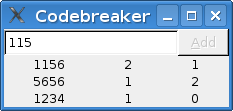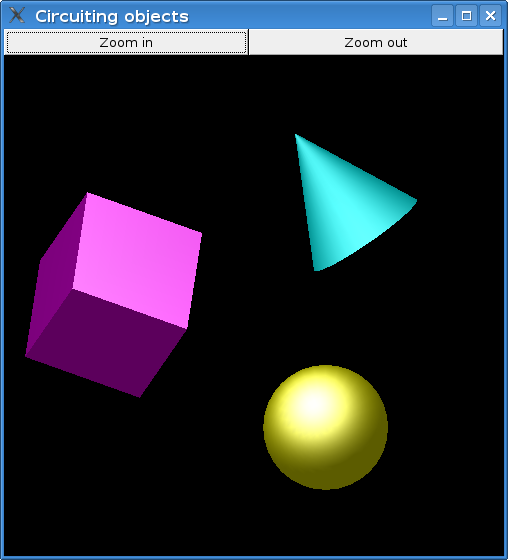Grapefruit
About
Grapefruit is a library for Functional Reactive Programming (FRP) with a focus on user interfaces. FRP makes it possible to implement reactive and interactive systems in a declarative style. With Grapefruit, user interfaces are described as networks of communicating widgets and windows. Communication is done via different kinds of signals which describe temporal behavior.
Features
Grapefruit has the following important features:
- a push-based FRP implementation where signals
- can be memoized using ordinary variable bindings
- can be merged without doubling of simultaneous events
- cannot behave differently by starting them at different times
- a record system which makes it possible that
- input signals can be left out to get default behavior
- output signals can be left out to ignore uninteresting data
- output signals can be chosen and fetched by pattern matching
- an abstract UI implementation which can work with different backends which in turn use different toolkits to provide different look and feel with one and the same application code
At the moment, the only supported UI toolkit is GTK+ (via Gtk2Hs). We plan to support Qt in the future, making use of the HQK project’s output.
Versions
Grapefruit has undergone fundamental interface and implementation changes in late 2008 and early 2009. A version without these changes is available as the “classic” version. The classic version contains support for animated graphics, incrementally updating list signals and a restricted form of dynamic user interfaces (user interfaces whose widget structure may change).
The current development version does not have these features at the moment. Graphics support is expected to come back later if someone finds the time to port the respective code to the new Grapefruit interface. List signal and dynamic UI support is intended to come back in a much more generalized form.
A stable release of Grapefruit is expected to happen at the end of January 2009.
Download
The current version can be fetched from the darcs repository at http://softbase.org/grapefruit/darcs/main. If you want to try out the classic version, please get it from the darcs repository at http://softbase.org/grapefruit/darcs/classic.
Building
You need at least GHC 6.10.1 and Gtk2Hs 0.9.13 to build and use Grapefruit. GHC 6.8.2 can not be used because of GHC bug #1981. Gtk2Hs 0.9.12.1 might be okay but you would have to change the gtk dependency in grapefruit-ui-gtk/grapefruit-ui-gtk.cabal in order to use it. Grapefruit was tested with GHC 6.8.3 and Gtk2Hs 0.9.13 as well as GHC 6.10.1 and a pre-0.10.0 development version of Gtk2Hs.
In addition to Gtk2Hs, you will need a couple of other Haskell libraries. These are all available from Hackage. Cabal will tell you what libraries it wants. Alternatively, you can have a look at the build dependency specifications in the files grapefruit-*/grapefruit-*.cabal.
If you get warnings of the form “Can’t find interface-file declaration for type constructor or class …” when compiling grapefruit-ui or grapefruit-ui-gtk with GHC 6.8.3 then don’t panic. This seems to be because of a bug in the (non-official) type family support of GHC 6.8.3. However, it seems to be harmless.
Grapefruit consists of the following packages, each residing inside an equally-named directory in the source tree:
- grapefruit-frp
- grapefruit-records
- grapefruit-ui
- grapefruit-ui-gtk
- grapefruit-examples
You can use Cabal to build each single package.
There is also a Setup.lhs script in the root directory of the source tree which simplifies the building process. Alas, it only works with older Cabal versions so that it is not usable with the Cabal that comes with GHC 6.10.1. For building the complete Grapefruit library (including examples) in place with this script, run the following command:
runghc Setup.lhs up-to-register configure-options -- build-options -- --inplace further-register-options
If you rather want to install Grapefruit in some directory, use this command:
runghc Setup.lhs up-to-install configure-options -- build-options -- install-options
Running the examples
The package grapefruit-examples of the classic versions provides an executable for each example. Since the current version is able to use different UI toolkits (at least in theory), it would not be wise to create executables since these would be fixed to one specific toolkit. Therefore, in the current version, grapefruit-example provides a toolkit-independent library. To run an example, start GHCi and type the following:
import Graphics.UI.Grapefruit.Circuitimport Graphics.UI.Grapefruit.YourToolkitimport Examples.Grapefruit.YourExamplerun YourToolkit mainCircuit
At the moment, the only meaningful replacement for YourToolkit is GTK and the only meaningful replacement for YourExample is Simple.
Documentation
At the time of writing, Grapefruit lacks documentation seriously. For the current version, documentation should follow very soon. The first official release will most likely contain complete API documentation. There are no plans for providing complete API documentation for the classic version. You will have to live with what’s there. If you have questions, you may always ask the author of Grapefruit as listed in the *.cabal files.
Publications and talks
The following publications and talks are related to Grapefruit:
- Wolfgang Jeltsch: Declarative Programming of Interactive Systems with Grapefruit. Software Technology Colloquium of Utrecht Universiteit. May 29, 2008.
- time, place and abstract
- slides (including non-shown additional material)
- Wolfgang Jeltsch: Improving Push-based FRP. 9th Symposium on Trends in Functional Programming. May 26–28, 2008.
- draft paper (published in the draft proceedings)
- slides (including non-shown additional material)
- Wolfgang Jeltsch: Funktionale GUI-Programmierung in Haskell mit Grapefruit. Haskell in Leipzig 2. July 10, 2007.
Screenshots
Following are some screenshots from the examples of the classic version:
- Simple
- Clicking on the button adds a star to the caption of the button. This doesn’t look very meaningful. However, Simple is actually a very important example since it demonstrates that feedbacks work—the output of the button is transformed and then used as the button’s input.

- Codebreaker
- This is a Mastermind™-like game. The Add button is enabled if and only if the input field contains a valid code and the display box is enabled if and only if the list of guesses does not contain the code chosen by the computer. These properties are described in a declarative way in the source code.

- CircuitingObjects
- This example demonstrates Grapefruit’s support for animations.
